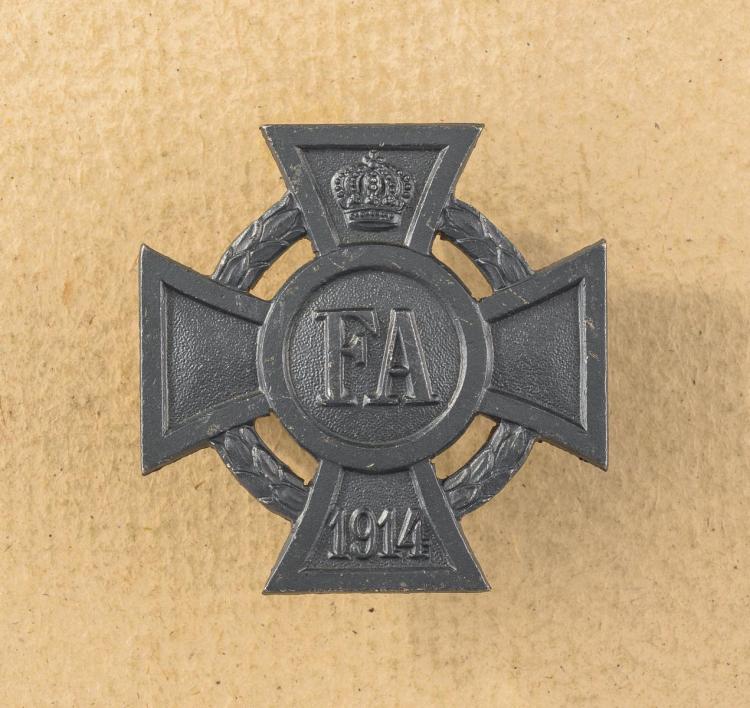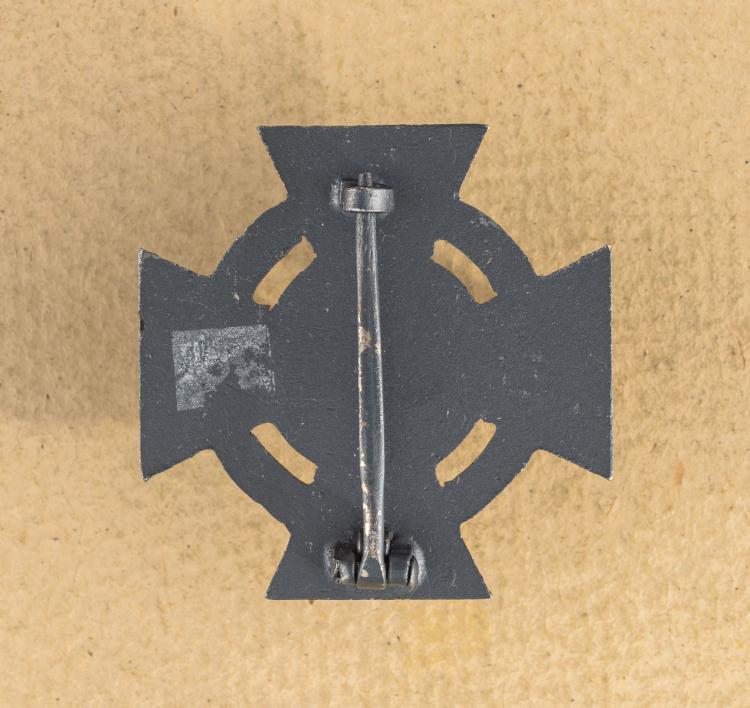-
Posts
58 -
Joined
-
Last visited
Profile Information
-
Location
home
Recent Profile Visitors
The recent visitors block is disabled and is not being shown to other users.
camelneck's Achievements
-
Unlike the other photos, the last cross in this series of photos is entirely one color: a yellowish bronze or brass This leads me to a question. When these crosses were originally issued were the grids inside each cross arm (and the grids inside the center circle) coated with a dark or blackish lacquer (like a Brunswick War Merit Cross or an Iron Cross)? Or did the gridded areas become dark overtime as a result of dirt, tarnish, etc. I always assumed that the gridded areas were blackened, but the photo of the last cross made me wonder. (Of course, someone could have cleaned this cross and removed the original black lacquer.) Just curious ....
-
Last year, I bought a Friedrich-August Cross 1st class from the Thies Auction (USA). Before I bought it, I noticed that it looked a little smaller than the normal-size 1st class F-A Cross, so I only placed a bid of $35. However, that was enough to win the cross. (BTW, it was listed as an original period piece and not a reproduction.) When I received the cross, I measured it and found it to be around 38 to 39mm wide which is the width for a 2nd class cross. (I believe most (if not all) first class crosses have a width of 44 to 45mm.) I might also add that my FA cross is non-magnetic, but I'm aware that many of these were made of blackened bronze or zinc. (My cross appears to be made of zinc or white metal.) I think it might be a private-purchase piece from the 1920's or 1930's. However, I thought I would ask for some opinions since I don't claim to be an expert on this particular award. (FWIW, the white substance on the left arm (reverse side) of the cross was residue from a sticker that has since been removed.)
-

Poland Polish Cross of Merit
camelneck replied to Brian Wolfe's topic in Central & Eastern European States
I just bought my first set of Polish Awards today when I ran across a deal that I couldn't refuse. I got this entire set of 3 crosses for 15 Euros (5 Euros for each cross). Too bad they didn't have swords. -
About 8 months ago, I bought a Floch EK1 (99% sure it is a Floch) from an online auction house, East Bristol Auction (UK). I might add that the auction house didn't claim it was an original piece so I thought it might be a Floch when I bought it. (I kind of wanted a Floch for future reference and I only paid $60 so I'm not complaining.) I do have a couple of questions about Floch EK1's:: 1) When (what era) were Floch's made? I'm willing to bet that the piece I have is at the very least 40 to 50 years old maybe a lot older. 2) Somebody once told me that Floch's (or at least some of them) were private purchase pieces that were made in the 1950's and 60's. He said they were sold to soldiers and tourists who wanted cheap war souvenirs. Is there any truth to this? 3) Many militaria dealers are now selling reproductions (as reproductions) and their businesses seem to be thriving. I've seen some who sell cheap, one-piece iron cross reproductions for around $20. Others sell nicer 3-piece iron crosses for $40 - $50 and there are a few who sell very convincing reproductions for prices that range from $80 to $120. That being said, what would an "advertised Floch EK1" that is in good condition be worth? (By "advertised", I mean a Floch EK1 that is being sold as a reproduction.)
-

3rd Reich Medal bars... Show Yours!
camelneck replied to Gary B's topic in Wehrmacht Medals, Decorations & Awards
Wow, Gary, did you rob a museum! :) Most of my medal bars have ribbons with a bit of dirt and a couple of them have a small stain or two. Every one of your bars look like they were put under glass in a museum as soon as they were made. Awesome collection! -

Romanian Order of the Star- quick question
camelneck replied to P.F.'s topic in Central & Eastern European States
Hi Carol, Thanks for your understanding! I really appreciate your helpful comments. Patience is a virtue when it comes to looking for the proper medal and ribbon. David -

Romanian Order of the Star- quick question
camelneck replied to P.F.'s topic in Central & Eastern European States
Hi Carol, I now see where this exchange went sour and I will take the blame for it all. When I wrote "It is on the peacetime ribbon with rosette for Type 1 (WW1) Order of the Crown, instead of the peacetime ribbon for Type 2 (WW2) Order of the Crown", I should have never wrote the 2nd "peacetime". It was a typo that I never caught until you pointed it out. When I wrote the paragraph that contained the above sentence, I was trying to give a brief (yet totally unnecessary) explanation as to why I asked my original question. Thus when I wrote my last comment, I must admit that I was a bit miffed because It never dawned on me that such an afterthought would draw so much criticism or I would have drafted a more careful explanation. However, now that I understand your point of view, I was wrong to view your comments as a personal attack and I apologize for being so defensive. You wrote, "Some dealer practices are indeed questionable, to say the least, and one should strive to restore the award to its original condition, including matching the ribbon with the award." I totally agree with your sentiments and I believe it is our duty to try and preserve history the best we can. But on the other hand, while this sounds nice in theory, one has to remember that these awards are nearly 80 years old and I'm certain that the majority of these awards no longer come with the original ribbon that came with them during the presentation ceremony. Just because an award comes with a vintage WW1 ribbon, one has no way of knowing if this is the original ribbon that came with the award, a correct vintage replacement ribbon, an incorrect vintage replacement ribbon, a correct modern replacement ribbon, or an incorrect modern replacement ribbon. (Of course, most collectors can differentiate between a vintage replacement ribbon and a modern replacement ribbon.) So what should we do with the awards that are being sold without ribbons? Let them go forever ribbonless or try and find them a proper replacement ribbon even if we aren't sure that the replacement ribbon is the original ribbon? I've heard of crooked dealers and collectors who intentionally put non-combat ribbons on combat awards (and vice-versa) in order to sell them for a lot more money. This is especially common if the same ribbon is used for more than one award. In this particular case, they remove vintage ribbons from the cheaper awards and put them on more expensive, yet naked, awards. Thus, I think it is naive to think that just because a medal comes with a vintage ribbon this means that it is the original ribbon unless the award comes with a certificate of authenticity. As these awards continue to changed hands, this degree of uncertainty will only increase as time progresses. -

Romanian Order of the Star- quick question
camelneck replied to P.F.'s topic in Central & Eastern European States
Actually, Romania signed the Tripartite Pact on November 23,1940 so one could argue that they became involved in WW2 in 1940 although they didn't join the invasion of the Soviet Union until June 1941. -

Romanian Order of the Star- quick question
camelneck replied to P.F.'s topic in Central & Eastern European States
Carol, I'm aware that Type 2 awards were issued between 1932 and 1947. WW2 is a subset of this period. This redundancy was included so people who were not familiar with Type 1 and Type 2 awards would understand that Type 1 awards were issued during WW1 and Type 2 awards were issued during WW2. I do apologize for any confusion this may have caused. >>You first mention that the award should have the peacetime ribbon, but then you say that you have two wartime ribbons for which you are looking for rosettes. << I never said my Order of the Crown award "should have the peacetime ribbon". That is an assumption that you made. I said my Type 2 Order of the Crown came with the wrong ribbon, which was a Type 1 Peacetime ribbon (complete with rosette). In fact, the dealer who sold me this Type 2 Order of the Crown is notorious for buying naked medals and dressing them up with the closest ribbon that is readily available to him, which in this case was a Type 1 Romanian Order of the Crown ribbon with rosette. Since there is a very good chance that the person (likely the dealer) who put this improper Type 1 peacetime ribbon on my award had no idea whether the original ribbon was a Type 2 peacetime ribbon, a Type 2 1938 Wartime ribbon, or a red-blue battlefield (Military Virture) ribbon, it is improper to make the assumption that this is a peacetime award and that I must replace it with Type 2 peacetime ribbon. What if this award came with black and white WW1-era iron cross ribbon? It wouldn't mean I would have to replace it with black, white, and red WW2-era iron cross ribbon. That being the case, I found and purchased some Type 2 1938 Wartime Ribbon as well as some red-blue battlefield (Military Virtue) ribbon. The first ribbon in which I can find a matching rosette will be the ribbon that I use. (If I can find a Type 2 peacetime ribbon complete with a matching rosette, I'll gladly use that ribbon instead of the other two ribbons that I have already purchased.) -

Romanian Order of the Star- quick question
camelneck replied to P.F.'s topic in Central & Eastern European States
Thanks a lot Carol. I thought I remembered seeing some rosettes on the military virtue (wartime) ribbon (as you posted). I have an Officer's Class Order of the Star award (just like the one in the photo that you posted) except mine is on the peacetime ribbon (red with silver stripes) and it has a rosette. However, I have an Order of the Crown (Type 2 or WW2 variety) and it is on an incorrect ribbon. It is on the peacetime ribbon with rosette for Type 1 (WW1) Order of the Crown, instead of the peacetime ribbon for Type 2 (WW2) Order of the Crown. I have found and bought two types of replacement ribbons for this award--a wartime (non-battlefield) ribbon with gold edges and the military virtue or battlefield ribbon (red with blue edges). However, since both of these ribbons require rosettes when they are used with an Officer's Class medal, I need to find a rosette for at least one of these 2 ribbons. Anybody have any rosettes for sale? -

Romanian Order of the Star- quick question
camelneck replied to P.F.'s topic in Central & Eastern European States
Hi, I have a question regarding Officer's Class awards and ribbons. Suppose the photo showing the 4 silver Knight's Cross of Order of the Star were actually 4 gilded Officer's Cross of Order of the Star. I assume the first 2 awards (leftmost) would have rosette's on the ribbon. However, in regards to the two remaining (rightmost) award, would they have a rosette since they are on war ribbons?? I am most concerned about award #4 (red-blue ribbon) since it is a Battlefield ribbon. I remember reading somewhere that when a 4th Class (Officer's Class) Bulgarian Military Merit Award is suspended from the light blue with silver stripes (wartime or bravery ribbon) that the wartime/bravery ribbon does not have a rosette. I wondered if this applies to Romanian awards hung from either the wartime or battlefield ribbons. David -

King Ferdinand I's decorations
camelneck replied to ilieff's topic in Central & Eastern European States
I've seen this award in various photos, but never knew what it was until now! Thanks! -

King Ferdinand I's decorations
camelneck replied to ilieff's topic in Central & Eastern European States
Does anybody know the name of medal #4 (the cross fleury), which is located between the Austrian 60th year Jubilee Cross of 1908 and the Polish Order of the White Eagle? It looks a bit like the Order of Michael The Brave (3rd class) (which I think Ferdinand was awarded), but that particular order has blue enamel and a crimson ribbon with gold edge stripes. Thanks.




